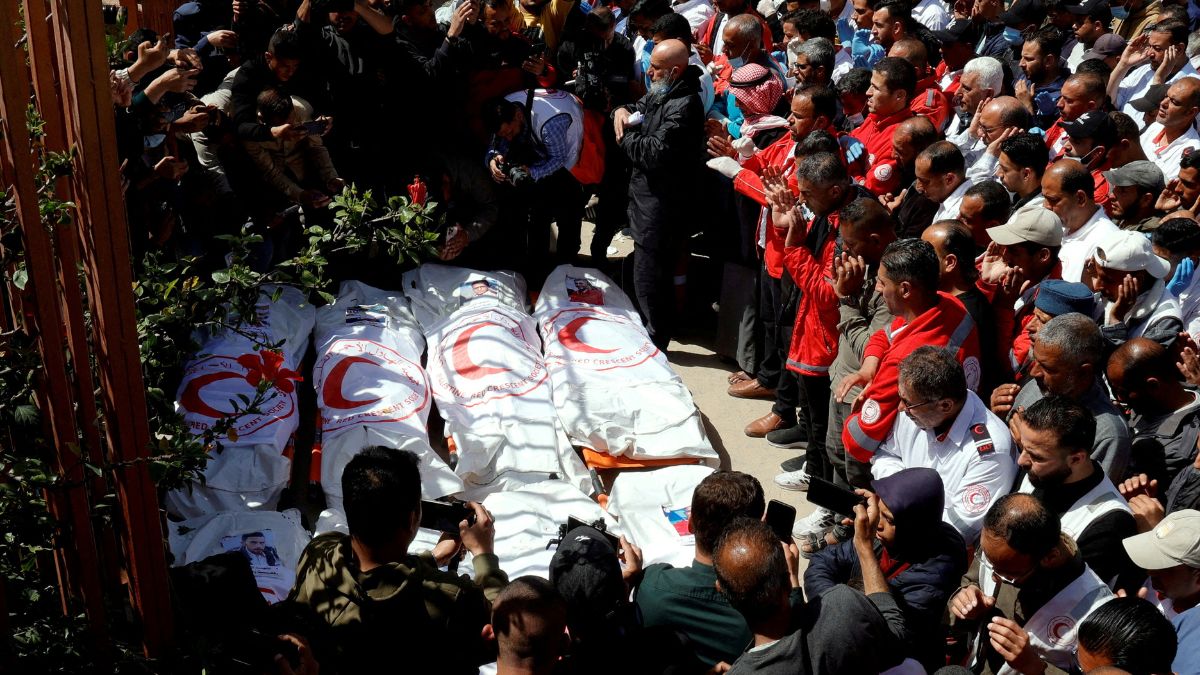Death of Red Crescent paramedics: Israel accepts mistake
 Palestinians mourn medics, who came under Israeli fire while on a rescue mission, after their bodies were recovered, according to the Red Crescent, at Nasser hospital in Khan Younis in the southern Gaza Strip | Reuters
Palestinians mourn medics, who came under Israeli fire while on a rescue mission, after their bodies were recovered, according to the Red Crescent, at Nasser hospital in Khan Younis in the southern Gaza Strip | Reuters
The Israeli Defence Forces (IDF) publicly acknowledged yesterday that their soldiers had made grave errors in the killing of 15 emergency workers, including 14 Red Cross officials and one additional aid worker, in Rafah, southern Gaza, on March 23. The incident, which also left another survivor injured, ranks among the deadliest IDF attacks on international aid personnel in the ongoing conflict. The admission came after mobile phone footage contradicted the military’s initial claims, prompting a rethink.
The tragic events unfolded in the pre-dawn hours of March 23 near Tel Sultan in Rafah. At 4:30am, the IDF’s Golani Brigade laid an ambush targeting Hamas forces, successfully neutralising them. Over the next hour and a half, various vehicles, including ambulances, passed through the area uneventfully.
But around 6am, as daylight emerged, a convoy of Palestinian Red Crescent Society (PRCS) ambulances, a UN car and a fire truck approached. From concealed positions, IDF troops perhaps misjudged the clearly marked vehicles as a Hamas threat and unleashed a barrage of gunfire.
The initial justification from Israel was that the attack was triggered by the suspicious movement of the convoy, with its headlights switched off and without any emergency indicators. However, that turned out to be false as footage shot by paramedic Refat Radwan, later obtained by, showed the vehicles with headlights and flashers on, responding to an emergency call. The five-minute clip ended hauntingly with Radwan reciting his last prayers as Israeli soldiers’ voices closed in, undermining the IDF’s early account and forcing them to retract it as “mistaken.”
Dr Bashar Murad, a senior official of the Palestine Red Crescent, told reporters that one of the paramedics who was present at the site was speaking on the phone with colleagues at the time. The man, who had been wounded, was reaching out to request assistance.
According to the IDF, the soldiers acted on aerial surveillance reports flagging the convoy’s approach as suspicious. Having earlier clashed with Hamas at 4am—killing two militants and detaining a third—the troops assumed the ambulances, which stopped near a Hamas vehicle, signalled a fresh threat.
The military later claimed at least six of the 15 victims were Hamas operatives, though they offered no public evidence, citing classified intelligence. The Red Crescent, UN and the Red Cross firmly maintain that all those killed were unarmed aid workers.
After realising their error, the IDF notified the UN, gathered the bodies in a net, and provided coordinates for retrieval. When the UN couldn’t locate them, the military, upon returning to the area, buried the remains in a shallow mass grave to shield them from wild animals and combat damage.
On March 30, aid teams finally uncovered the site, finding the bodies alongside crushed vehicles and Radwan’s phone, which preserved the critical footage.
Briefing journalists yesterday, an IDF official promised a “thorough examination” of the incident, denying claims that the medics were handcuffed or executed at close range—assertions challenged by a surviving paramedic who told the BBC the convoy was visibly lit and his colleagues unaffiliated with militants.
The IDF has repeatedly claimed that Hamas uses ambulances to transport its leaders and cadres. There may be some truth to it, but the Rafah incident, which appears unjustified, has put it in a tight spot.
The killings, meanwhile, have sparked widespread outrage, with the Red Crescent and other international rights groups calling for an unbiased investigation. The video evidence and conflicting testimonies have cast doubt on the credibility of the IDF’s ongoing probe, leaving the Netanyahu administration a lot to answer for.
Middle East